If your goat has a low-protein diet or has been feeding on low-quality hay, taking feeds is an excellent option to boost its nutrition. Making your own may not necessarily be cheaper, but you can use local and highly nutritious ingredients. Most conventional animal feeds rely heavily on corn and soybeans as the main ingredients. Goats are so efficient at extracting nutrients that for every three pounds of hay fed to a goat, it will consume two pounds of fiber.
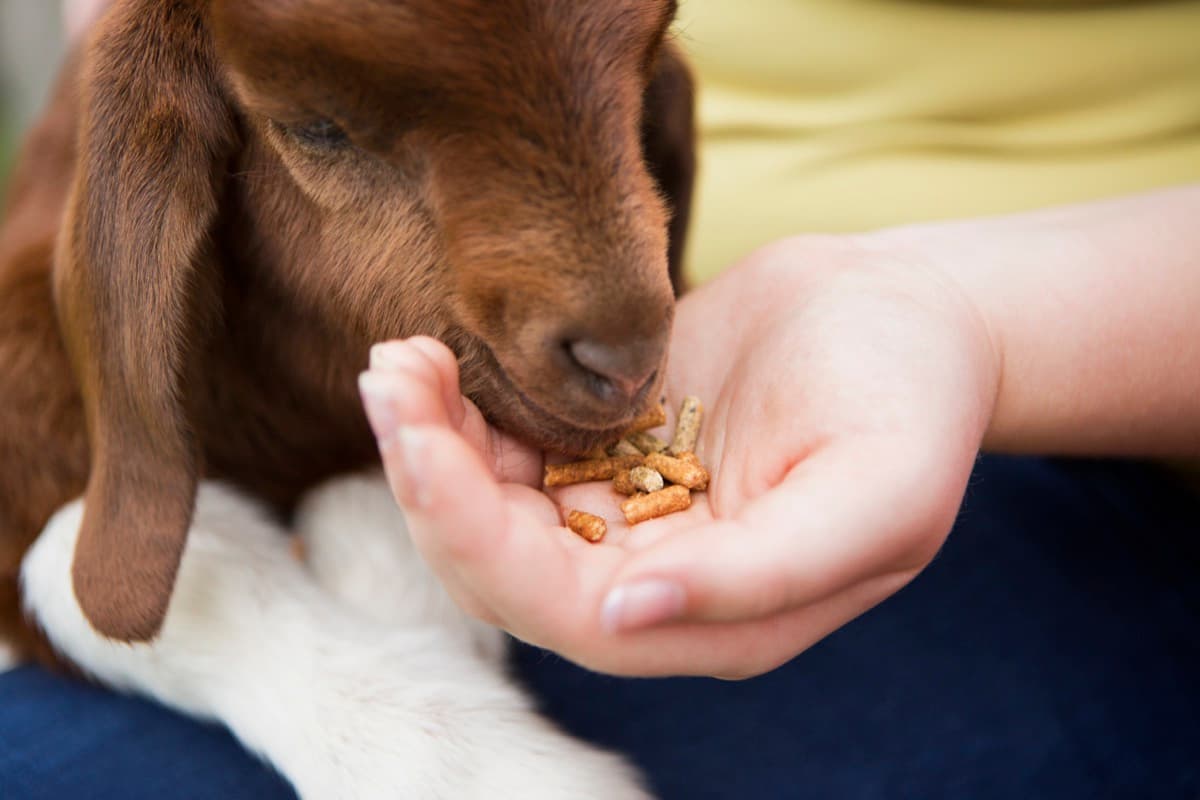
Homemade goat feed recipes
Reasons for making own goat feed
Feeding your goats with your recipe can save you a lot of money and is much healthier for your goats in the long run. There are many reasons people choose to make their feed for their goats. Some people want to control the ingredients in their goat’s food, some want to feed their goats a varied diet, and some want to save money.
Though buying the pre-mix at the stores may be quicker and more convenient for busy farm life, it is always more expensive than buying our raw ingredients and mixing them. But not only is it cheaper, but it is also healthier for your goats. To keep your goats healthy and thriving, feed them a well-balanced diet.
A good goat feed recipe includes hay, fresh vegetables, and a small number of pellets. Feed your goats morning and evening, and provide plenty of fresh water. Keep an eye on your goat’s weight. They can easily gain weight if they aren’t getting enough exercise or eating too much hay. Ensure they always have enough water, too – dehydration can cause problems for your goat.
In case you missed it: Key Rules to Start Goat Farming in Denmark: Business Plan, Setup Cost, Profit, and Management
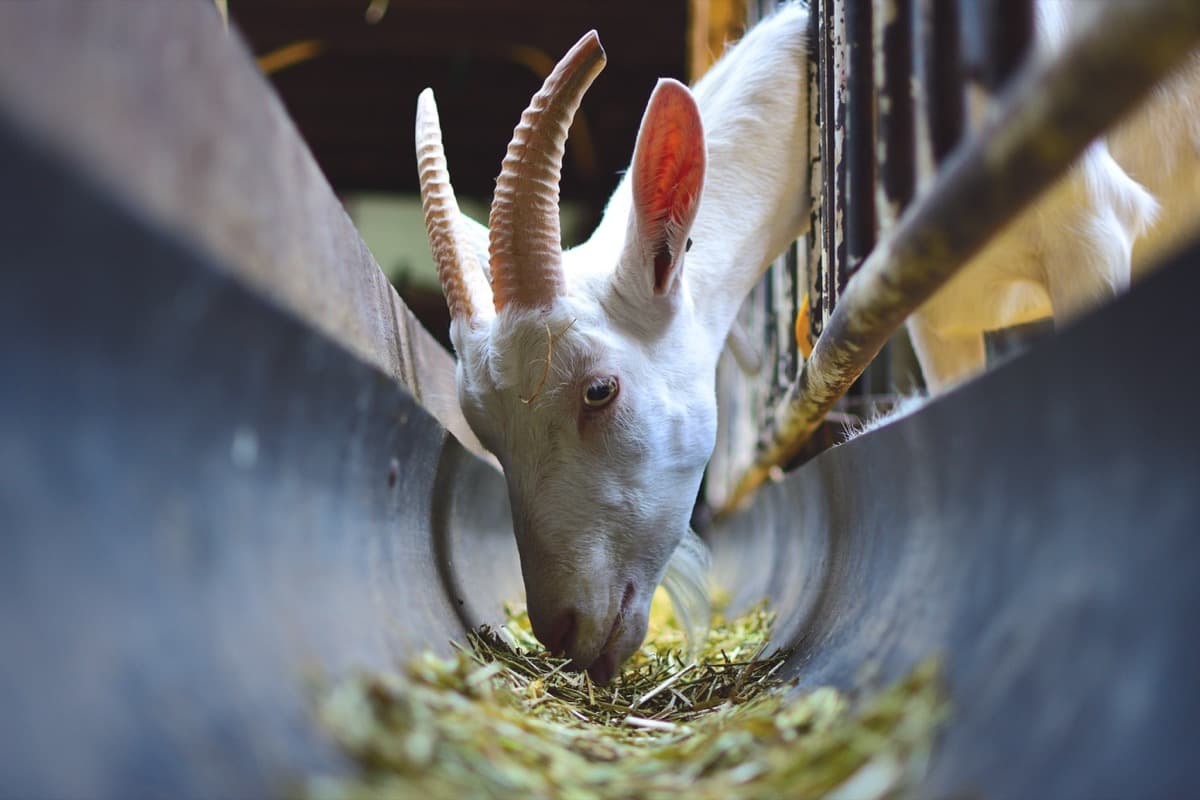
Tips for feeding your goats
Goat owners can use a variety of grains as their animal feed, including rolled oats, barley, corn, wheat, and rice. Make sure to choose a grain appropriate for your goats’ climate and the type of diet you want them to eat. For example, barley is a good option for cold climates because it has a high protein content. On the other hand, corn is a good choice for warm climates because it provides energy without being too dense or heavy in the stomach. Hay is essential for goats, and many different types are available on the market today.
If you’re using fresh hay, make sure to pick up some when you go shopping so that your goats have something to eat while waiting for their feed to cook. If you’re using hay that’s been stored away break it up into small pieces so that it will be easier for goats to digest. Making goat feed is a simple process that can be achieved with a few common ingredients. The important thing is to provide enough feed for the goat, as overfeeding can lead to obesity and health problems.
To make goat feed, you will need hay, straw, a bag or container to store the feed in, and water. Hay should account for around 60% of the total feed intake, while straw should make up around 20%. The remaining 10% can be made up of other types of fodder, such as maize or other grains. To prepare the feed, mix hay, straw and any other type of fodder you use. Then fill your chosen container or bag with the mixture and water until it reaches the desired volume.
Ensure the goats have access to fresh water while feeding them this food. Goats need a good diet to thrive, and a high-quality hay or pasture diet is ideal. If you have access to fresh green grass, give them plenty of that. Goats need plenty of water to stay healthy, and they will drink more if available in an easy-to-access spot. Also, goats will eat more if their food is given regularly rather than out of hunger or boredom.
Try feeding them every two hours or so, depending on the size of your herd and their metabolism rates. Monitor the goats’ weight and condition regularly to ensure they receive the right food. In addition, keep an eye out for potential health problems, such as diarrhea or bloat, and take appropriate steps to address them promptly.
Make your goat feeds
- You can adjust the proportions of different ingredients to create a feed specifically tailored to your livestock’s needs. This allows you to avoid paying high prices for premade feeds and ensures that the feed contains all the nutrients your animals need.
- Creating your mix can save money on supplies and improve profitability. Also, homemade feeds typically contain more nutrients than commercially-made feeds, so they are likely to be healthier for your livestock too.
- When using premade feeds, there is always a risk that ingredients may not be suitable for your livestock or may not provide them with the correct level of nutrition. By creating your mixes, however, you ensure that all ingredients are safe and appropriate for use with your animals.
- Goats are good for the environment because they eat a lot of weeds and other plants that would otherwise be lawn grass or crops. They also produce methane, a natural gas, as they digest their food. This gas is not harmful and can even be used to generate electricity.
- Another benefit of feeding goats is that they provide milk, which is high in protein and calcium. Add small quantities of food at a time to avoid overfeeding. Goats will eat quickly, so be sure not to leave food on the ground where they can get to it. If you find that your goat is eating too much or not eating enough, try adding more hay or reducing the amount of grain in their diet.
In case you missed it: Goat Farming Loan in India: How to Get, Interest Rate, Documents for Banks, Mudra, and NABARD
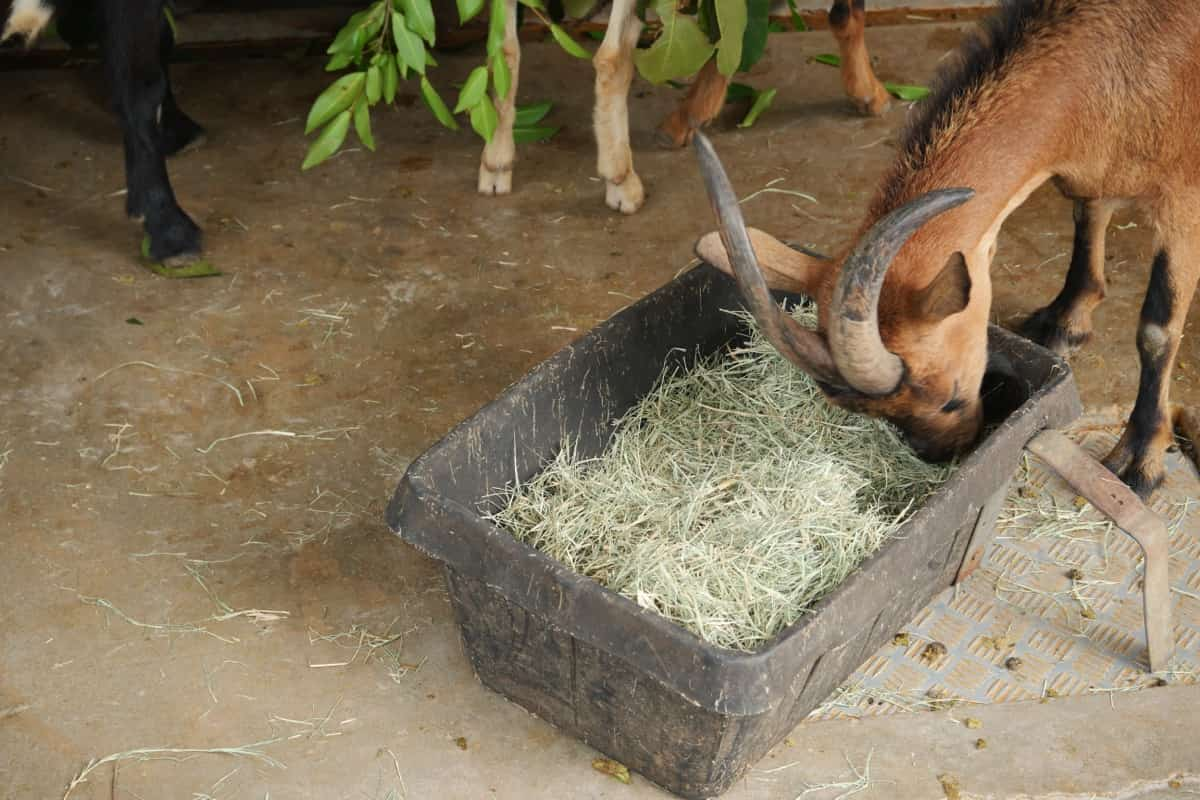
What is the best thing to feed goats to gain weight?
Many things can be fed to goats to gain weight, but hay is the best thing to feed them. Hay is low in calories and high in fiber, which makes it a great source of nutrition for goats. The fastest and healthiest way to put weight on a goat is to feed them a diet high in carbohydrates, like grains, corn, or oats.
Goat feed recipes
Recipe 1
- 150 lbs Alfalfa pellets
- 50 lbs oats
- 25 lbs steam-rolled barley
- 15 lbs BOSS (black oil sunflower seeds)
- 10 lbs soybean meal
To make the feed, measure out the alfalfa pellets. Add them to a large bag and crush them using your hands. You want the pellets to be ground into small pieces but not so small that they become dust. Next, add the oats to the bag and mix well. Next, use a hand mixer to blend everything until the oats are broken down but not so much that they become powdery. Finally, add the steam-rolled barley and soybean meal and mix well again. Your goat feed is now ready to be stored in a cool, dry place or fed to your animals immediately.
Recipe 2: Homemade Organic Goat Feed Mix
Homemade goat feed mix is a great way to save money and improve the goat’s diet quality.
Ingredients
- 2 cups Organic Whole Barley
- 2 cups Organic Whole Oats (or 75% whole, 25% rolled)
- 2 cups Alfalfa Pellets
- 1 cup Organic/Non-GMO Corn
- ½ cup BOSS (Black Oil Sunflower Seeds)
- ½ cup Organic Pumpkin Seeds
You’ll also need 2 tsp. of kelp and 2 tbs. of brewer’s yeast. Finally, add molasses to give your goats the extra nutrients they need to thrive
Recipe 3
Ingredients
- Oats
- Barley
- Black Oil Sunflower Seeds
- Cracked Corn
- Apple Cider Vinegar (Optional)
- Water (Optional)
- 5 Gallon Plastic Bucket
If you have a 5-gallon plastic bucket, that will make things a lot easier. Add all of the ingredients to the bucket and stir well. Make sure the oats, barley, and sunflower seeds are evenly distributed. Now place the bucket in a warm place and let it sit for 24 hours. After 24 hours, your feed is ready to feed to your goats.
In case you missed it: How to Make Corn Silage: Production and Management Steps for Goats, Sheep, Cows, Pigs, and Cattle
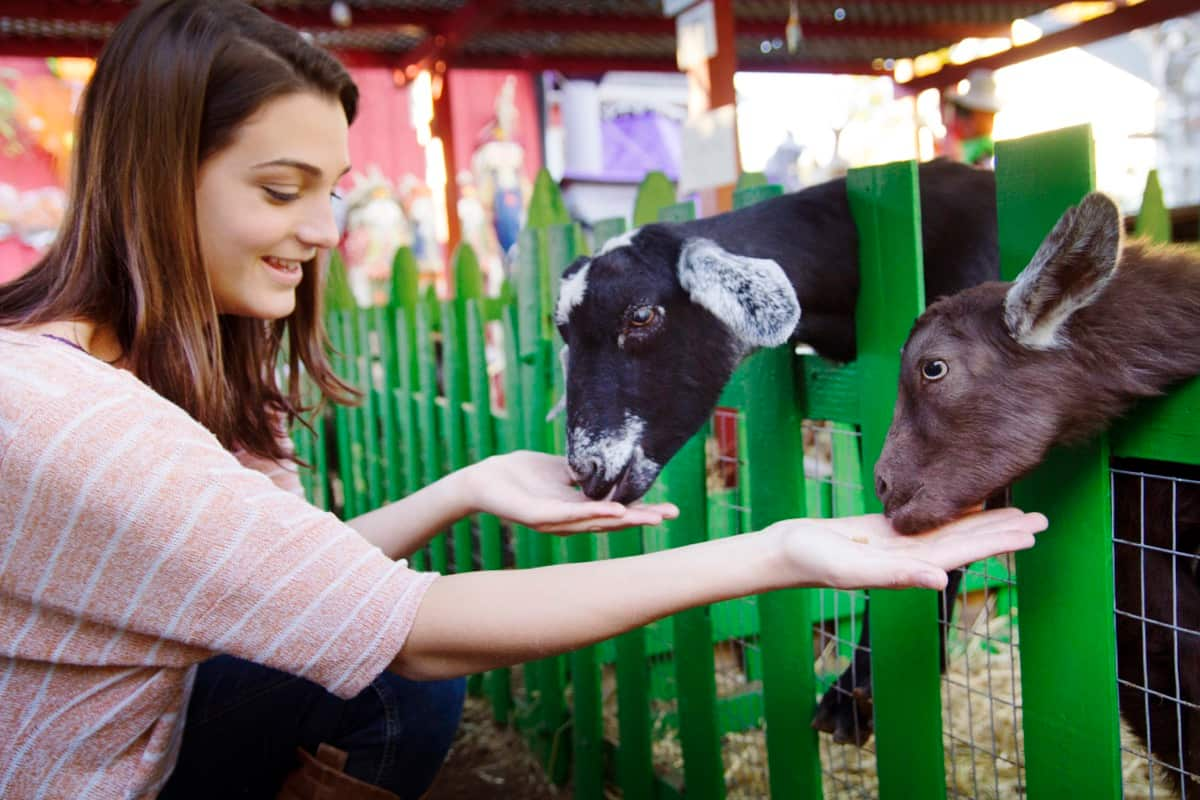
Recipe 4
The main ingredients are Alfalfa, Barley, Oats, Beans, Carob, and Sunflower Seeds.
The ratio for this recipe is:
- Alfalfa pellets: 4 parts
- Barley: 3 parts
- Oats: 3 parts
- Broad beans: 1 part
- Carob: 1 part
Calculate the total amount and add 2% of the weight of sunflower seeds. This homemade goat feed recipe can be given to goats based on weight.
- Milking goat: 1800 grams
- Pregnant goat: 1400 grams
- Normal goat: 1000 grams
- Billy goat in breeding season: 1200grams
- Billy goat not in breeding season: 200grams
Recipe 5
The main ingredients are Barley, Oats, Linseed Meal, Kelp meal, Molasses
- Rolled barley: 50 lbs
- Crushed oats: 50 lbs
- Linseed meal: 3 lbs
- Kelp meal: 1lb
- Molasses (to combine all ingredients)
To mix this recipe, first mix barley and oats well together. Then scatter the linseed and kelp meal. Finally, coat the mixture with molasses. How much molasses is needed depends on the thickness you want your grain to be. On average, 12 cups of molasses in each 100lbs grain is a suitable ratio. This recipe can last up to 50 days in big metal containers during cool, dry days. If it is humid and hot where you live, the storage time will be altered.
Recipe 6
This recipe will involve sprouting your grains. The ingredients include:
- Barley (11% protein): 5 parts
- Winter peas: 1 part
- Wheat berries: 1 part
- Millet: 2 parts
- Oats: 2 parts
In case you missed it: Indigenous Veld Goat Farming in Africa: How to Start, Business Plan for Rasing to Care
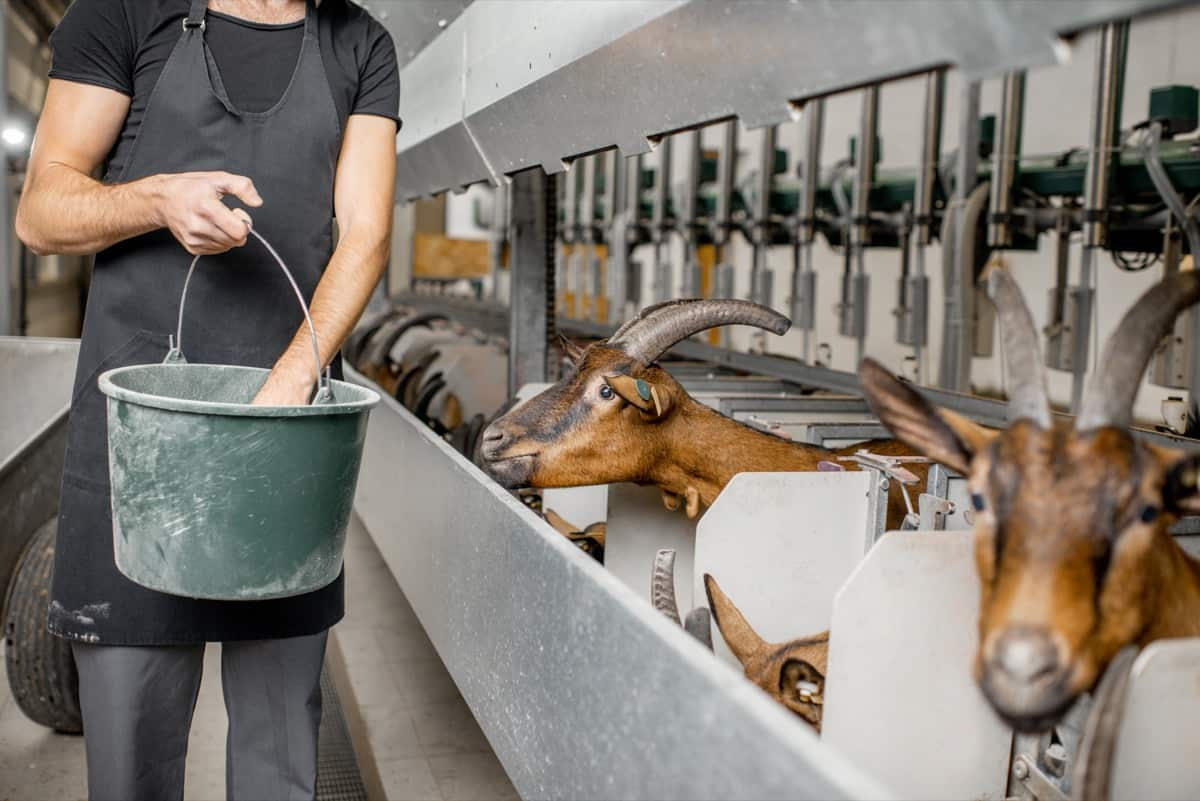
To begin, rinse the grains in a fine mesh strainer. Next, spread the grains on a floured surface and sprout for 3-5 days, stirring daily. Once sprouted, rinse the grains and store them in an airtight container.
Barley is a great feed for goats, as it is high in fiber and, therefore, slow to convert to energy. It also contains 11% protein, which is important for milk production. This recipe uses wheat berries and millet as the main grain sources, while oats provide additional texture. This feed can be supplemented with hay, fresh vegetables or fruit, or mineral supplements if desired.
Recipe 7
Ingredients
- 1 cup of hay or straw
- 2 cups of fresh vegetables (any kind will do, but carrots and apples are favorites)
- 1 cup of dried fruit (raisins, apricots, cranberries)
- 1/2 cup of salt
- 1 teaspoon of black pepper
- 3 tablespoons of oil or butter
Start by combining the hay or straw, fresh vegetables, dried fruit, salt, and black pepper in a large bowl. Mix well and then divide the mixture among your goats’ feeding bowls. Add enough water so that the feed is evenly moistened. (You can add more water if necessary). Adding canned water will also work fine if you have trouble watering your goats from a hose due to drought conditions or other factors. Just shake any excess off before giving the goats their feed.
What should you not feed a goat?
It would help if you did not feed your goats leftover meat scraps, garlic, onions, caffeine, citrus fruits, chocolate, avocadoes, raw potatoes, kale, and quite a few different natural flowers and bushes.
In case you missed it: How to Start Goat Farming in South Africa: Business Plan, Breeds, Cost, Profit, and Management
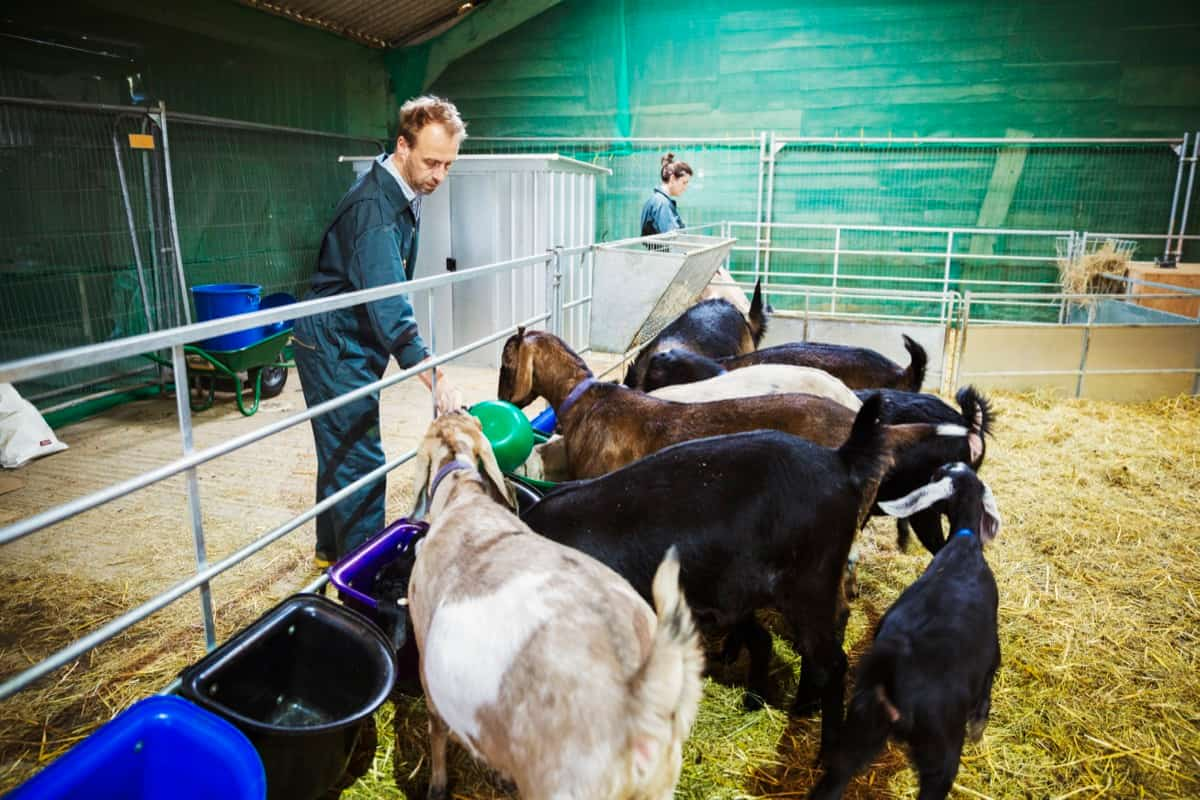
Conclusion
Goats are ruminants, meaning they can eat almost any type of food. They thrive best when they’re exposed to an adequate pasture. Goats usually browse, meaning they don’t just feed on the grass on the ground.
- Types of Pesticides Used in Agriculture: A Beginner’s Guide
- Economical Aquaculture: A Guide to Low-Budget Fish Farming
- 15 Common Planting Errors That Can Doom Your Fruit Trees
- How to Make Houseplants Bushy: Effective Tips and Ideas
- Innovative Strategies for Boosting Coconut Pollination and Yield
- Pollination Strategies for Maximum Pumpkin Yield
- The Complete Guide to Chicken Fattening: Strategies for Maximum Growth
- Natural Solutions for Tulip Problems: 100% Effective Remedies for Leaf and Bulb-Related Issues
- Revolutionizing Citrus Preservation: Towards a Healthier, Greener Future
- Natural Solutions for Peony Leaf and Flower Problems: 100% Effective Remedies
- Maximizing Profits with Avocado Contract Farming in India: A Comprehensive Guide
- Natural Solutions for Hydrangea Problems: 100% Effective Remedies for Leaf and Flowers
- The Ultimate Guide to Choosing the Perfect Foliage Friend: Bringing Life Indoors
- From Sunlight to Sustainability: 15 Ways to Use Solar Technology in Agriculture
- The Ultimate Guide to Dong Tao Chicken: Exploring from History to Raising
- The Eco-Friendly Makeover: How to Convert Your Unused Swimming Pool into a Fish Pond
- Mastering the Art of Delaware Chicken Farming: Essentials for Healthy Backyard Flocks
- 20 Best Homemade Fertilizers for Money Plant: DIY Recipes and Application Methods
- How to Craft a Comprehensive Free-Range Chicken Farming Business Plan
- Brighten Your Flock: Raising Easter Egger Chickens for Beauty and Bounty
- How to Optimize Your Poultry Egg Farm Business Plan with These Strategies
- Subsidy for Spirulina Cultivation: How Indian Government Schemes Encouraging Spirulina Farmers
- Ultimate Guide to Raising Dominique Chickens: Breeding, Feeding, Egg-Production, and Care
- Mastering the Art of Raising Jersey Giant Chickens: Care, Feeding, and More
- Ultimate Guide to Raising Legbar Chickens: Breeding, Farming Practices, Diet, Egg-Production
- How to Raise Welsummer Chickens: A Comprehensive Guide for Beginners
- How to Protect Indoor Plants in Winter: A Comprehensive Guide
- Ultimate Guide to Grow Bag Gardening: Tips, Tricks, and Planting Ideas for Urban Gardeners
- Guide to Lotus Cultivation: How to Propagate, Plant, Grow, Care, Cost, and Profit
- Agriculture Drone Subsidy Scheme: Government Kisan Subsidy, License, and How to Apply Online
- Ultimate Guide to Raising Araucana Chickens: Breed Profile, Farming Economics, Diet, and Care
- Bringing Hydroponics to Classroom: Importance, Benefits of Learning for School Students
- Ultimate Guide to Raising Polish Chickens: Breed Profile, Farming Economics, Diet, and Care
- Ultimate Guide to Raising Australorp Chickens: Profile, Farming Economics, Egg Production, Diet, and Care
- Silkie Chicken Farming: Raising Practices, Varieties, Egg Production, Diet, and Care
- Sussex Chicken Farming: Raising Practices, Varieties, Egg Production, Diet and Care
Will try one of these recipes. Thanks